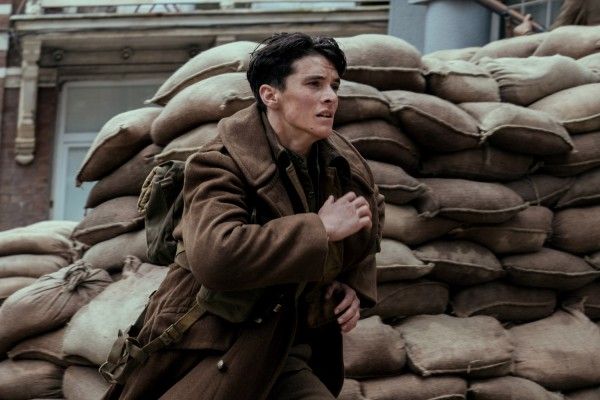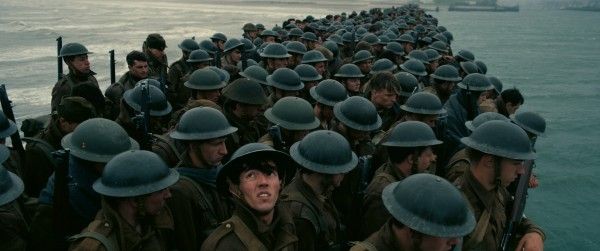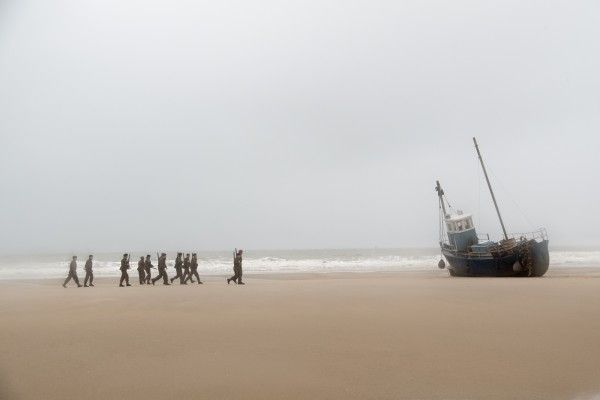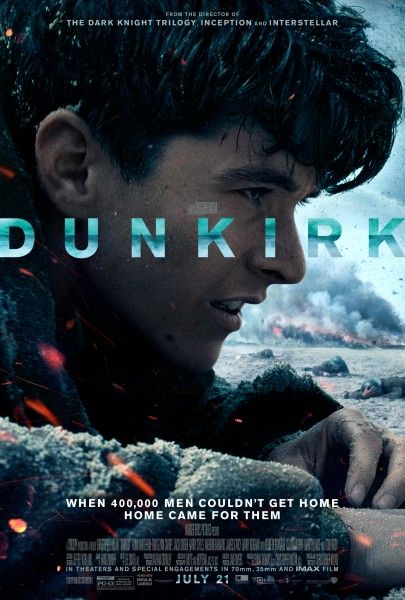Dunkirk isn’t just a departure for writer-director Christopher Nolan; it’s a departure for mainstream cinema as a whole. A movie without a protagonist, much of a story, or distinct characters, Dunkirk is largely about the experience, but not in a “theme park” sense. Rather than try and give a broad overview of Operation Dynamo and the particulars of rescuing 400,000 soldiers from the beaches of Dunkirk, Nolan wants to put the viewer as close to the action as possible in order to feel the need for survival. In one way, it’s a cold, distant look at a massive military operation; but the immediacy of the scenes instantly humanizes characters even if we don’t know their names. Nolan plays by his own rules, and while the execution sometimes feels a bit remote, we’re always trapped inside the director’s exquisitely crafted pressure cooker.
The movie jumps across three timelines all dealing with the British evacuation of Dunkirk during World War II. There’s “The Mole” (i.e. the shoreline), which takes place over the course of a week and follows young British soldier Tommy (Fionn Whitehead) and a fellow fighter (Damien Bonnard) as they try to find a way out of Dunkirk. There’s “The Sea”, which takes place during the course of a day and follows Mr. Dawson (Mark Rylance), his son Peter (Tom Glynn-Carney), and his friend George (Barry Keoghan) as they sail from Britain to Dunkirk to rescue soldiers. Finally, there’s “The Air”, which takes place over the course of an hour and follows British pilots Farrier (Tom Hardy) and Collins (Jack Lowden) providing air support for the ships below.
But almost none of these characters matter as individuals. I had to look up the names of just about everyone because within the context of Dunkirk, they’re all part of a much larger story that dwarfs everyone involved. Nolan isn’t interested in the particulars of how Dunkirk happened or how it was solved. He’s not even that interested in the backstories of most of his characters and their relationships (I spent half the film wondering if George was Dawson’s son). Everything in Dunkirk is about what’s happening at that very moment where death could strike at any time, and there’s no escape from battle.
And yet the movie constantly feels like Nolan is pushing against his PG-13 rating in terms of showing the brutality of war. On the one hand, he arguably doesn’t need to go where films like Saving Private Ryan have been because we all know war is hell, so showing blood and guts littering the beaches may seem gratuitous. However, that hellish environment is necessary because it would further convey the desperation of the soldiers to get off the beach and the bravery of those who went in to rescue them. It’s to Nolan’s credit that he’s able to wring as much intensity out of the situation as he can while still avoiding gore, but the bloodless battle detracts from the immediate reality the director wants to present.
In many ways, Dunkirk feels like Nolan is challenging himself in a way he never has before, coming right up to the line of what could be a vanity project, but making sure that the audience is more unnerved that entertained. The risk in using an unconventional approach for a true story like Operation Dynamo is you might inadvertently be disrespectful to the memory of those who lived and died in that situation. If Nolan had gone in and said, “This seems like a good scenario for me to try out some new IMAX tricks,” the entire enterprise would have fallen apart.
Instead, Nolan is challenging himself to try and tell a war story in a different way. A conventional narrative for Dunkirk would have been easy, and instead Nolan breaks out a completely unexpected approach, going with a triptych story that jumps between timelines that will ultimately intersect while never paying too much attention to any one character. For some, this approach won’t be enough, and at times Dunkirk admittedly falls short as we care for every single character in a very generalized sense, but rarely do we feel the connection we get from Mr. Dawson’s quiet dignity or the affection Peter feels for George. That’s not to say that the characters are placeholders, but rather they’re part of a larger milieu Nolan wants to convey.
From a visual craft perspective, you’re seeing a filmmaker at the top of his game. While other filmmakers use IMAX to just fill the frame with as much CGI garbage as possible, Nolan understands the power of negative space and using it to dwarf his characters or put the audience in the middle of the action. I saw the film in RPX, and I was a bit annoyed they didn’t hold the screening in 70mm IMAX, which is clearly Nolan’s preferred format and the best way to see the movie. And yet, the film is such an intense experience and so draining even at an hour and forty-six minutes that I have a tough time convincing myself to drive an hour to the Mall of Georgia and pay $21 so I can have my nerves fried again.
There’s also a part of me that feels like Dunkirk is less than the sum of its parts. I can’t deny the power of Nolan’s direction or the astounding shots DP Hoyte Van Hoytema gets or the ingenious use of a clock tick in Hans Zimmer’s score. All of these things matter, and yet the paradox at the core of the movie—the immediacy of the action combined with the distant overview of events—turns Dunkirk into a frustrating experience that still demands to be seen.
Rating: B





